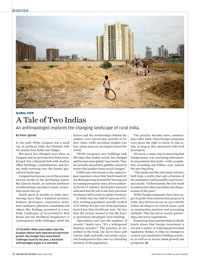In Review
In the early 1990s, Gurgaon was a small city in northern India that blended with the nearby farm fields and villages.
But much has changed since then, as Gurgaon and its environs have been transformed into a financial hub with modern office buildings, condominiums, and luxury malls towering over the former agricultural landscape.
Gurgaon has become one of the premier success stories in the developing nation. But Llerena Searle, an assistant professor of anthropology, says there’s more–or less–than meets the eye.
Searle spent 16 months in India interviewing more than a hundred investors, bankers, developers, contractors, architects, marketers, planners, consultants, and others. Her findings, presented in a new book, Landscapes of Accumulation: Real Estate and the Neoliberal Imagination in Contemporary India (Chicago), detail the factors and the relationships behind the sudden, even spectacular, growth of India’s cities, while providing insights into how urban areas are developed around the world.
“While Gurgaon’s new buildings look like signs that Indian society has changed and become more global,” says Searle, “they are actually speculative gambles, based on stories that predict those social changes.”
A Sikh man who invests in the capital region repeated a story that Searle heard often about growing demand for housing and increasing prosperity rates, driven primarily by the IT industry. But Searle’s research indicated that the tale is one that real estate developers tell in order to attract investors.
In 2008, only one-half of 1 percent of India’s working population actually worked in IT. Ninety-five per cent of the population earned less than $4,400 per year—far less than the income needed to buy the luxury apartments developers were building.
“Speculation isn’t just the madness of crowds,” Searle says. “It’s a widespread business practice.” The practice, as described in the book, has led to fancy golf courses, high-end malls, and ornate corporate headquarters that cater to a shrinking minority of the population.
The practice became more commonplace after 2005, when foreign companies were given the right to invest in real estate, as long as they partnered with local developers.
Of course, a major step in attracting that foreign money was convincing international corporations that India—with a population exceeding one billion—was, indeed, the next big thing.
“The media and the real estate industry both hype a reality that only a fraction of the population could possibly experience,” says Searle. “Unfortunately, the end result is construction that exacerbates the dispossession of the poor.”
While foreign companies have been eager to profit from construction projects in India, they did not see eye-to-eye with the Indian developers on critical issues, such as construction practices and accounting methods. That has led to uneasy partnerships and tense negotiations.
Examining those partnerships in detail, Searle shows that foreign investment is not just a matter of reducing government regulation. Rather, it relies on attempts to control and standardize building practices, as well as on stories about growth and prosperity.

